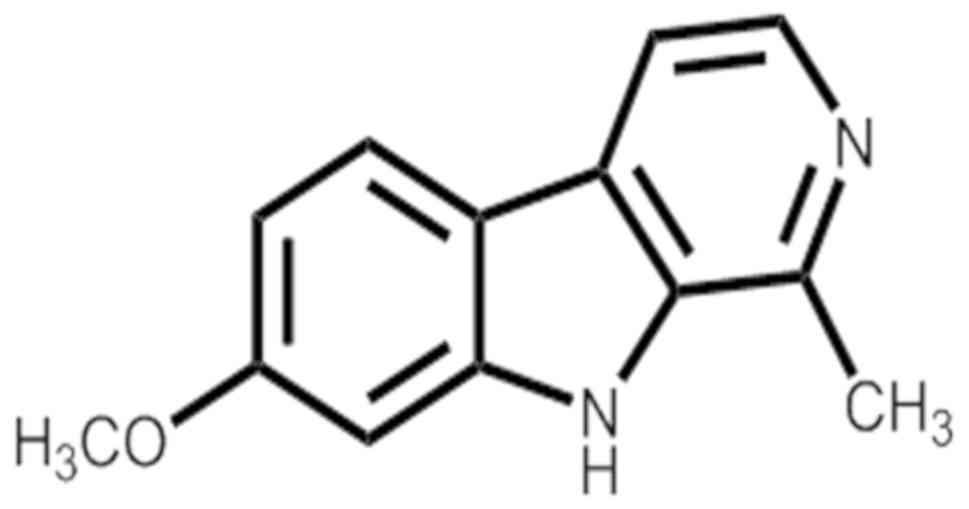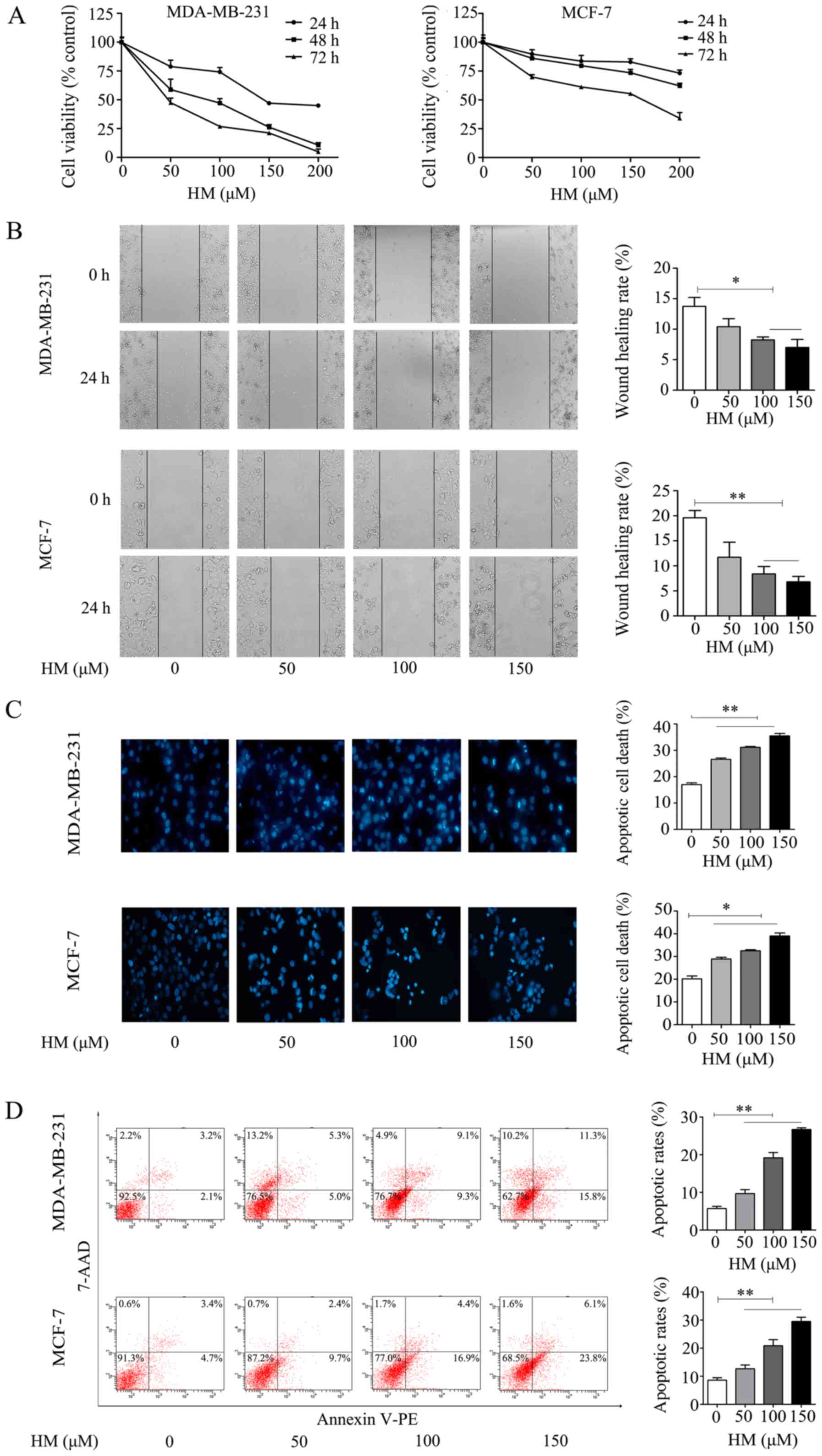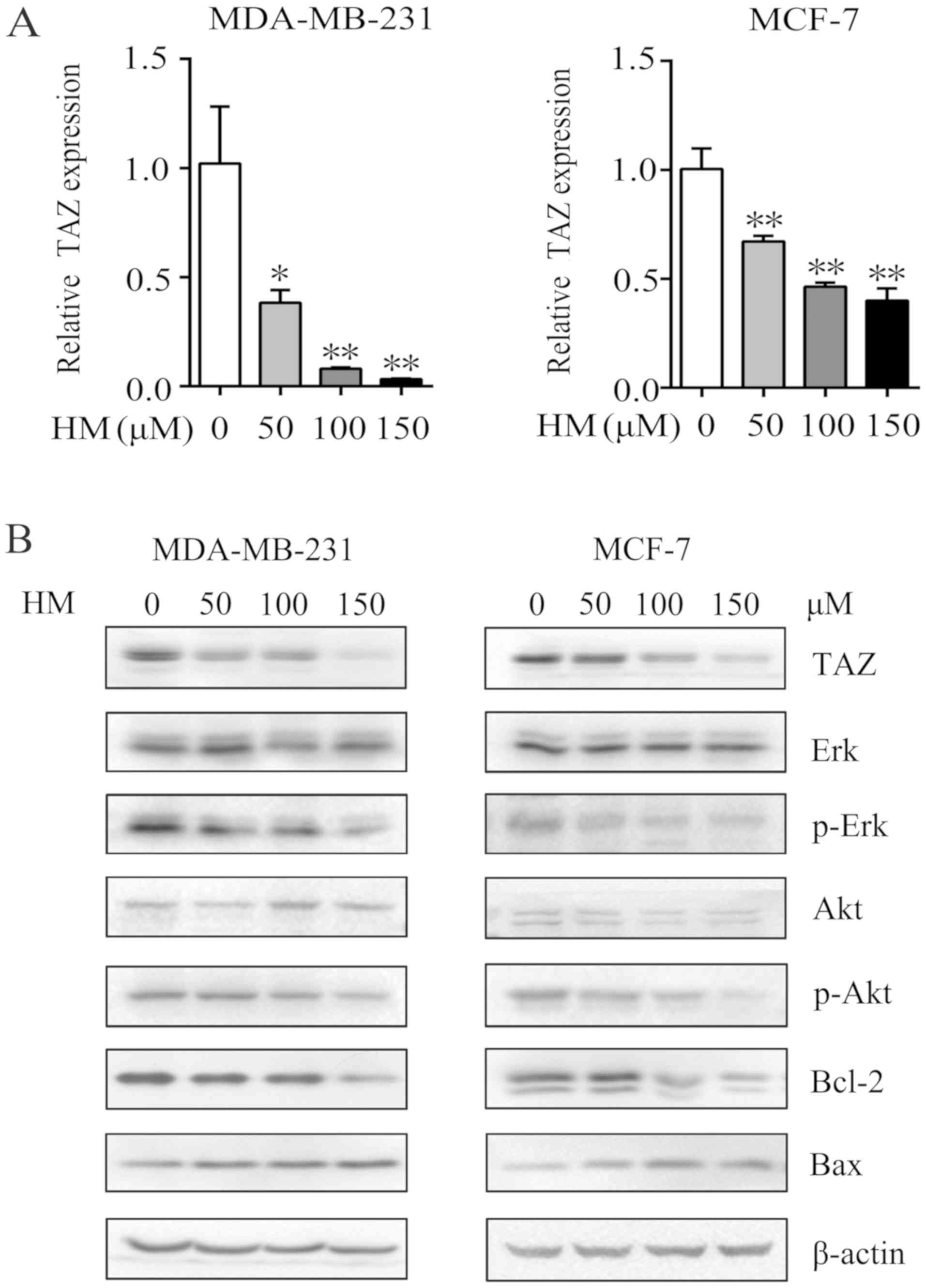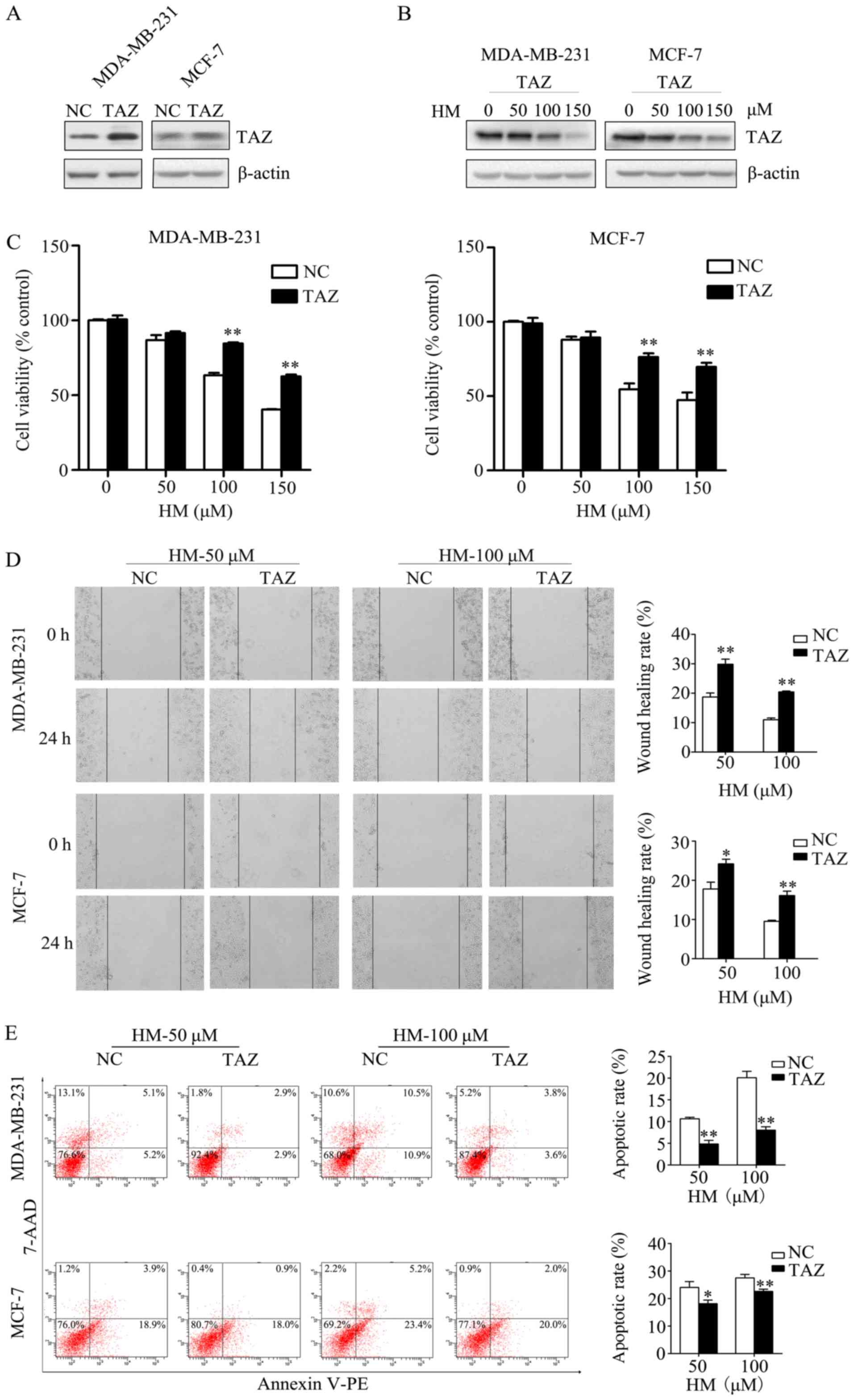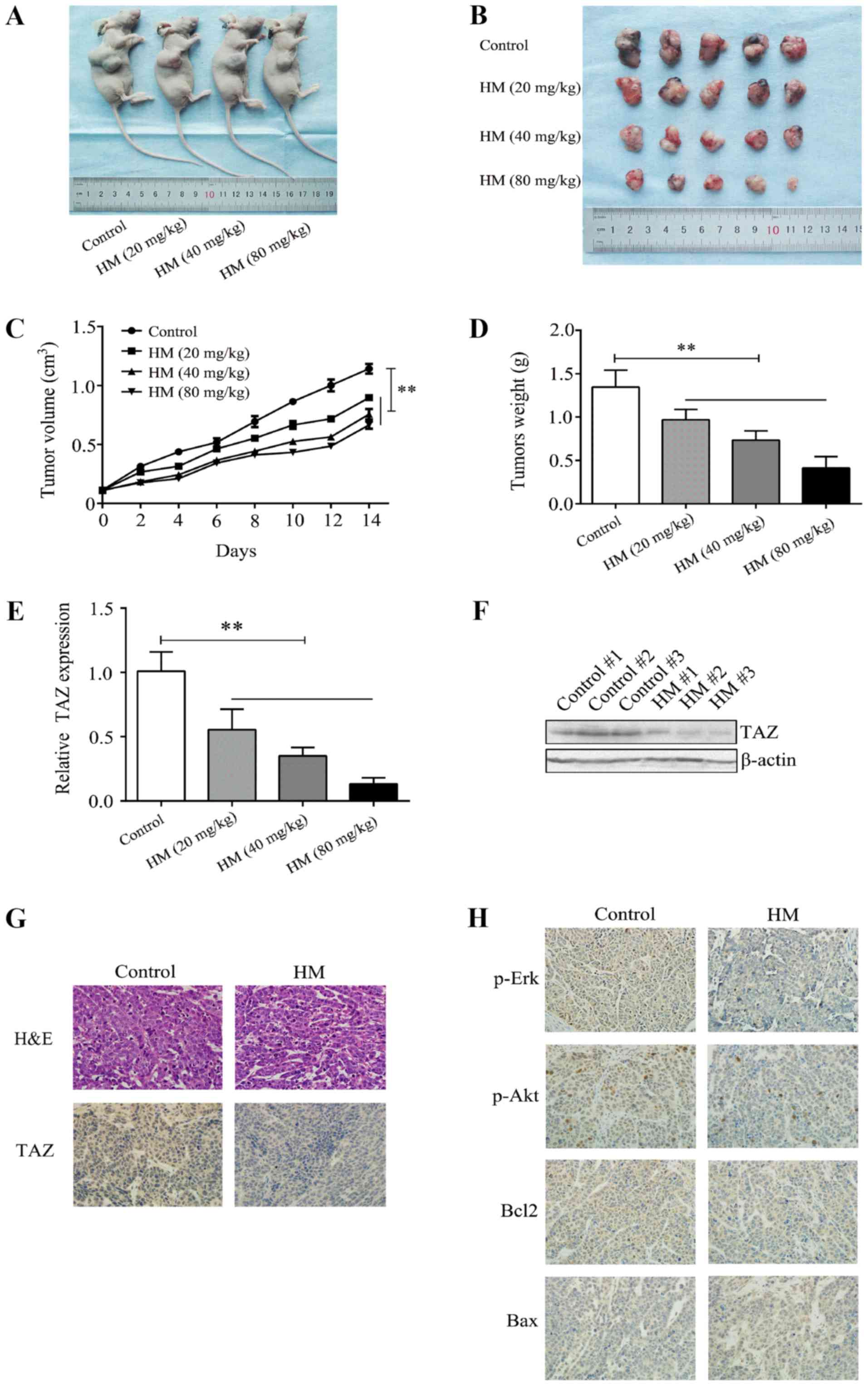|
1
|
Siegel RL, Miller KD and Jemal A: Cancer
statistics, 2016. CA Cancer J Clin. 66:7–30. 2016. View Article : Google Scholar : PubMed/NCBI
|
|
2
|
Chang L, Weiner LS, Hartman SJ, Horvath S,
Jeste D, Mischel PS and Kado DM: Breast cancer treatment and its
effects on aging. J Geriatr Oncol. 10:346–355. 2019. View Article : Google Scholar
|
|
3
|
Nathanson KL and Domchek SM: Therapeutic
approaches for women predisposed to breast cancer. Annu Rev Med.
62:295–306. 2011. View Article : Google Scholar
|
|
4
|
Patel K, Gadewar M, Tripathi R, Prasad SK
and Patel DK: A review on medicinal importance, pharmacological
activity and bioanalytical aspects of beta-carboline alkaloid
‘Harmine’. Asian Pac J Trop Biomed. 2:660–664. 2012. View Article : Google Scholar
|
|
5
|
Berrougui H, Martín-Cordero C, Khalil A,
Hmamouchi M, Ettaib A, Marhuenda E and Herrera MD: Vasorelaxant
effects of harmine and harmaline extracted from Peganum harmala L.
seeds in isolated rat aorta. Pharmacol Res. 54:150–157. 2006.
View Article : Google Scholar : PubMed/NCBI
|
|
6
|
Chen Q, Chao R, Chen H, Hou X, Yan H, Zhou
S, Peng W and Xu A: Antitumor and neurotoxic effects of novel
harmine derivatives and structure-activity relationship analysis.
Int J Cancer. 114:675–682. 2005. View Article : Google Scholar
|
|
7
|
Zhang H, Sun K, Ding J, Xu H, Zhu L, Zhang
K, Li X and Sun W: Harmine induces apoptosis and inhibits tumor
cell proliferation, migration and invasion through down-regulation
of cyclo-oxygenase-2 expression in gastric cancer. Phytomedicine.
21:348–355. 2014. View Article : Google Scholar
|
|
8
|
Dai F, Chen Y, Song Y, Huang L, Zhai D,
Dong Y, Lai L, Zhang T, Li D, Pang X, et al: A natural small
molecule harmine inhibits angiogenesis and suppresses tumour growth
through activation of p53 in endothelial cells. PLoS One.
7:e521622012. View Article : Google Scholar
|
|
9
|
Li C, Wang Y, Wang C, Yi X, Li M and He X:
Anticancer activities of harmine by inducing a pro-death autophagy
and apoptosis in human gastric cancer cells. Phytomedicine.
28:10–18. 2017. View Article : Google Scholar : PubMed/NCBI
|
|
10
|
Abe A and Yamada H: Harmol induces
apoptosis by caspase-8 activation independently of Fas/Fas ligand
interaction in human lung carcinoma H596 cells. Anticancer Drugs.
20:373–381. 2009. View Article : Google Scholar : PubMed/NCBI
|
|
11
|
Hashemi Sheikh, Shabani S, Seyed Hasan,
Tehrani S, Rabiei Z, Tahmasebi Enferadi S and Vannozzi GP: Peganum
harmala L.'s anti-growth effect on a breast cancer cell line.
Biotechnol Rep (Amst). 8:138–143. 2015. View Article : Google Scholar
|
|
12
|
Zhang L, Zhang F, Zhang W, Chen L, Gao N,
Men Y, Xu X and Jiang Y: Harmine suppresses homologous
recombination repair and inhibits proliferation of hepatoma cells.
Cancer Biol Ther. 16:1585–1592. 2015. View Article : Google Scholar : PubMed/NCBI
|
|
13
|
Hamsa TP and Kuttan G: Harmine activates
intrinsic and extrinsic pathways of apoptosis in B16F-10 melanoma.
Chin Med. 6:112011. View Article : Google Scholar : PubMed/NCBI
|
|
14
|
Song Y, Kesuma D, Wang J, Deng Y, Duan J,
Wang JH and Qi RZ: Specific inhibition of cyclin-dependent kinases
and cell proliferation by harmine. Biochem Biophys Res Commun.
317:128–132. 2004. View Article : Google Scholar : PubMed/NCBI
|
|
15
|
Zou N, Wei Y, Li F, Yang Y, Cheng X and
Wang C: The inhibitory effects of compound Muniziqi granule against
B16 cells and harmine induced autophagy and apoptosis by inhibiting
Akt/mTOR pathway. BMC Complement Altern Med. 17:5172017. View Article : Google Scholar : PubMed/NCBI
|
|
16
|
Hamsa TP and Kuttan G: Harmine inhibits
tumour specific neo-vessel formation by regulating VEGF, MMP, TIMP
and pro-inflammatory mediators both in vivo and in vitro. Eur J
Pharmacol. 649:64–73. 2010. View Article : Google Scholar : PubMed/NCBI
|
|
17
|
Zhou X and Lei QY: Regulation of TAZ in
cancer. Protein Cell. 7:548–561. 2016. View Article : Google Scholar : PubMed/NCBI
|
|
18
|
Park KS, Whitsett JA, Di Palma T, Hong JH,
Yaffe MB and Zannini M: TAZ interacts with TTF-1 and regulates
expression of surfactant protein-C. J Biol Chem. 279:17384–17390.
2004. View Article : Google Scholar : PubMed/NCBI
|
|
19
|
Jeong H, Bae S, An SY, Byun MR, Hwang JH,
Yaffe MB, Hong JH and Hwang ES: TAZ as a novel enhancer of
MyoD-mediated myogenic differentiation. FASEB J. 24:3310–3320.
2010. View Article : Google Scholar : PubMed/NCBI
|
|
20
|
Varelas X, Samavarchi-Tehrani P, Narimatsu
M, Weiss A, Cockburn K, Larsen BG, Rossant J and Wrana JL: The
Crumbs complex couples cell density sensing to Hippo-dependent
control of the TGF-β-SMAD pathway. Dev Cell. 19:831–844. 2010.
View Article : Google Scholar : PubMed/NCBI
|
|
21
|
Cui CB, Cooper LF, Yang X, Karsenty G and
Aukhil I: Transcriptional coactivation of bone-specific
transcription factor Cbfa1 by TAZ. Mol Cell Biol. 23:1004–1013.
2003. View Article : Google Scholar : PubMed/NCBI
|
|
22
|
Mahoney WM Jr, Hong JH, Yaffe MB and
Farrance IK: The transcriptional co-activator TAZ interacts
differentially with transcriptional enhancer factor-1 (TEF-1)
family members. Biochem J. 388:217–225. 2005. View Article : Google Scholar : PubMed/NCBI
|
|
23
|
Hong JH, Hwang ES, McManus MT, Amsterdam
A, Tian Y, Kalmukova R, Mueller E, Benjamin T, Spiegelman BM, Sharp
PA, et al: TAZ, a transcriptional modulator of mesenchymal stem
cell differentiation. Science. 309:1074–1078. 2005. View Article : Google Scholar : PubMed/NCBI
|
|
24
|
Zhang H, Liu CY, Zha ZY, Zhao B, Yao J,
Zhao S, Xiong Y, Lei QY and Guan KL: TEAD transcription factors
mediate the function of TAZ in cell growth and
epithelial-mesenchymal transition. J Biol Chem. 284:13355–13362.
2009. View Article : Google Scholar : PubMed/NCBI
|
|
25
|
Hong JH and Yaffe MB: TAZ: A
beta-catenin-like molecule that regulates mesenchymal stem cell
differentiation. Cell Cycle. 5:176–179. 2006. View Article : Google Scholar : PubMed/NCBI
|
|
26
|
Zhou Z, Hao Y, Liu N, Raptis L, Tsao MS
and Yang X: TAZ is a novel oncogene in non-small cell lung cancer.
Oncogene. 30:2181–2186. 2011. View Article : Google Scholar : PubMed/NCBI
|
|
27
|
Wang L, Shi S, Guo Z, Zhang X, Han S, Yang
A, Wen W and Zhu Q: Overexpression of YAP and TAZ is an independent
predictor of prognosis in colorectal cancer and related to the
proliferation and metastasis of colon cancer cells. PLoS One.
8:e655392013. View Article : Google Scholar : PubMed/NCBI
|
|
28
|
Bhat KP, Salazar KL, Balasubramaniyan V,
Wani K, Heathcock L, Hollingsworth F, James JD, Gumin J, Diefes KL,
Kim SH, et al: The transcriptional coactivator TAZ regulates
mesenchymal differentiation in malignant glioma. Genes Dev.
25:2594–2609. 2011. View Article : Google Scholar : PubMed/NCBI
|
|
29
|
Zhou X, Wang S, Wang Z, Feng X, Liu P, Lv
XB, Li F, Yu FX, Sun Y, Yuan H, et al: Estrogen regulates Hippo
signaling via GPER in breast cancer. J Clin Invest. 125:2123–2135.
2015. View Article : Google Scholar : PubMed/NCBI
|
|
30
|
Cordenonsi M, Zanconato F, Azzolin L,
Forcato M, Rosato A, Frasson C, Inui M, Montagner M, Parenti AR,
Poletti A, et al: The Hippo transducer TAZ confers cancer stem
cell-related traits on breast cancer cells. Cell. 147:759–772.
2011. View Article : Google Scholar : PubMed/NCBI
|
|
31
|
Yang N, Morrison CD, Liu P, Miecznikowski
J, Bshara W, Han S, Zhu Q, Omilian AR, Li X and Zhang J: TAZ
induces growth factor-independent proliferation through activation
of EGFR ligand amphiregulin. Cell Cycle. 11:2922–2930. 2012.
View Article : Google Scholar : PubMed/NCBI
|
|
32
|
Xu W, Wei Y, Wu S, Wang Y, Wang Z, Sun Y,
Cheng SY and Wu J: Up-regulation of the Hippo pathway effector TAZ
renders lung adenocarcinoma cells harboring EGFR-T790M mutation
resistant to gefitinib. Cell Biosci. 5:72015. View Article : Google Scholar : PubMed/NCBI
|
|
33
|
Yuen HF, McCrudden CM, Huang YH, Tham JM,
Zhang X, Zeng Q, Zhang SD and Hong W: TAZ expression as a
prognostic indicator in colorectal cancer. PLoS One. 8:e542112013.
View Article : Google Scholar : PubMed/NCBI
|
|
34
|
Chan SW, Lim CJ, Guo K, Ng CP, Lee I,
Hunziker W, Zeng Q and Hong W: A role for TAZ in migration,
invasion, and tumori-genesis of breast cancer cells. Cancer Res.
68:2592–2598. 2008. View Article : Google Scholar : PubMed/NCBI
|
|
35
|
Livak KJ and Schmittgen TD: Analysis of
relative gene expression data using real-time quantitative PCR and
the 2(-Delta Delta C(T)) Method. Methods. 25:402–408. 2001.
View Article : Google Scholar
|
|
36
|
Chen H, Zhu G, Li Y, Padia RN, Dong Z, Pan
ZK, Liu K and Huang S: Extracellular signal-regulated kinase
signaling pathway regulates breast cancer cell migration by
maintaining slug expression. Cancer Res. 69:9228–9235. 2009.
View Article : Google Scholar : PubMed/NCBI
|
|
37
|
Pal I and Mandal M: PI3K and Akt as
molecular targets for cancer therapy: Current clinical outcomes.
Acta Pharmacol Sin. 33:1441–1458. 2012. View Article : Google Scholar : PubMed/NCBI
|
|
38
|
Geng X, Ren Y, Wang F, Tian D, Yao X,
Zhang Y and Tang J: Harmines inhibit cancer cell growth through
coordinated activation of apoptosis and inhibition of autophagy.
Biochem Biophys Res Commun. 498:99–104. 2018. View Article : Google Scholar : PubMed/NCBI
|
|
39
|
Cao MR, Li Q, Liu ZL, Liu HH, Wang W, Liao
XL, Pan YL and Jiang JW: Harmine induces apoptosis in HepG2 cells
via mitochondrial signaling pathway. Hepatobiliary Pancreat Dis
Int. 10:599–604. 2011. View Article : Google Scholar : PubMed/NCBI
|
|
40
|
Uhl KL, Schultz CR, Geerts D and Bachmann
AS: Harmine, a dual-specificity tyrosine phosphorylation-regulated
kinase (DYRK) inhibitor induces caspase-mediated apoptosis in
neuroblastoma. Cancer Cell Int. 18:822018. View Article : Google Scholar : PubMed/NCBI
|
|
41
|
Sasaki H: Roles and regulations of Hippo
signaling during preimplantation mouse development. Dev Growth
Differ. 59:12–20. 2017. View Article : Google Scholar
|
|
42
|
He J, Bao Q, Yan M, Liang J, Zhu Y, Wang C
and Ai D: The role of Hippo/yes-associated protein signalling in
vascular remodelling associated with cardiovascular disease. Br J
Pharmacol. 175:1354–1361. 2018. View Article : Google Scholar
|
|
43
|
Patel SH, Camargo FD and Yimlamai D: Hippo
Signaling in the Liver Regulates Organ Size, Cell Fate, and
Carcinogenesis. Gastroenterology. 152:533–545. 2017. View Article : Google Scholar :
|
|
44
|
Gregorieff A and Wrana JL: Hippo
signalling in intestinal regeneration and cancer. Curr Opin Cell
Biol. 48:17–25. 2017. View Article : Google Scholar : PubMed/NCBI
|
|
45
|
Watt KI, Harvey KF and Gregorevic P:
Regulation of Tissue Growth by the Mammalian Hippo Signaling
Pathway. Front Physiol. 8:9422017. View Article : Google Scholar : PubMed/NCBI
|
|
46
|
Kim W and Jho EH: The history and
regulatory mechanism of the Hippo pathway. BMB Rep. 51:106–118.
2018. View Article : Google Scholar : PubMed/NCBI
|
|
47
|
Yuan M, Tomlinson V, Lara R, Holliday D,
Chelala C, Harada T, Gangeswaran R, Manson-Bishop C, Smith P,
Danovi SA, et al: Yes-associated protein (YAP) functions as a tumor
suppressor in breast. Cell Death Differ. 15:1752–1759. 2008.
View Article : Google Scholar : PubMed/NCBI
|
|
48
|
Yu X, Long YC and Shen HM: Differential
regulatory functions of three classes of phosphatidylinositol and
phosphoinositide 3-kinases in autophagy. Autophagy. 11:1711–1728.
2015. View Article : Google Scholar : PubMed/NCBI
|
|
49
|
Tang D, Chen QB, Xin XL and Aisa HA:
Anti-diabetic effect of three new norditerpenoid alkaloids in vitro
and potential mechanism via PI3K/Akt signaling pathway. Biomed
Pharmacother. 87:145–152. 2017. View Article : Google Scholar : PubMed/NCBI
|
|
50
|
Lynch JT, McEwen R, Crafter C, McDermott
U, Garnett MJ, Barry ST and Davies BR: Identification of
differential PI3K pathway target dependencies in T-cell acute
lymphoblastic leukemia through a large cancer cell panel screen.
Oncotarget. 7:22128–22139. 2016. View Article : Google Scholar : PubMed/NCBI
|
|
51
|
Li YH, Fu HL, Tian ML, Wang YQ, Chen W,
Cai LL, Zhou XH and Yuan HB: Neuron-derived FGF10 ameliorates
cerebral ischemia injury via inh+ibiting NF-κB-dependent
neuroinflammation and activating PI3K/Akt survival signaling
pathway in mice. Sci Rep. 6:198692016. View Article : Google Scholar
|
|
52
|
Fujimori Y, Inokuchi M, Takagi Y, Kato K,
Kojima K and Sugihara K: Prognostic value of RKIP and p-ERK in
gastric cancer. J Exp Clin Cancer Res. 31:302012. View Article : Google Scholar : PubMed/NCBI
|
|
53
|
Roos DH, Puntel RL, Lugokenski TH, Ineu
RP, Bohrer D, Burger ME, Franco JL, Farina M, Aschner M, Rocha JB,
et al: Complex methylmercury-cysteine alters mercury accumulation
in different tissues of mice. Basic Clin Pharmacol Toxicol.
107:789–792. 2010. View Article : Google Scholar : PubMed/NCBI
|



